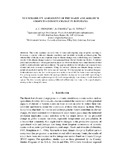| dc.contributor.author | Chipanshi, A.C. | |
| dc.contributor.author | Chanda, R. | |
| dc.contributor.author | Totolo, O. | |
| dc.date.accessioned | 2009-12-08T12:53:11Z | |
| dc.date.available | 2009-12-08T12:53:11Z | |
| dc.date.issued | 2004 | |
| dc.identifier.citation | Chipanshi, A.C. et al (2004) Vulnerability assessment of the maize and sorghum crops to climate change in Botswana, Climatic Change, vol. 61, no. 3, pp. 339-360. | en_US |
| dc.identifier.issn | 0165-0009 | |
| dc.identifier.issn | 1573-1480 | |
| dc.identifier.uri | http://hdl.handle.net/10311/412 | |
| dc.description.abstract | This study examines the sensitivity of maize and sorghum crops to global warming in
Botswana, a country with arid climatic conditions and shortfalls in locally produced grain. The
vulnerability of the maize and sorghum crops to climate change were studied using crop simulation
models while climate change scenarios were generated from Global Circulation Models. Simulated
yields indicated that rain-fed crop production under the observed climate was a small fraction of what
could be produced under optimal conditions. The gap was attributed to both physical (especially lack
of rain) and socio-economic constraints. Using the southern African core climate change scenario,
simulated yields declined by 36% in the case of maize and 31% for sorghum in the sand veldt region.
Yield reductions from the hard veldt region were in the order of 10% for both maize and sorghum.
The growing season became shorter, the average reduction in days in the sand veldt region being 5
and 8 days for maize and sorghum respectively, and correspondingly, 3 and 4 days over the hard veldt
region. The food security option currently followed in Botswana was found to be a good adaptive
strategy under a changed climate. | en_US |
| dc.language.iso | en | en_US |
| dc.publisher | Springer http://www.springerlink.com/content/p88867543584713 | en_US |
| dc.title | Vulnerability assessment of the maize and sorghum crops to climate change in Botswana | en_US |
| dc.type | Published Article | en_US |

